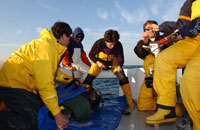Tag-A-Giant Foundation Scientific Advisor Dr. Barbara Block is co-author on a new paper published in the prestigious journal, Science, entitled, "Natal Homing and Connectivity in Atlantic Bluefin Tuna Populations." The paper was published online on October 2nd and will appear in print later in the month. The study corroborates previous electronic tagging and genetics work conducted by the TAG team and others that there are two unique populations of Atlantic bluefin tuna that do not interbreed but mix on foraging grounds in the North Atlantic. This is the first research to quantify the level of mixing based on feeding area.
The paper analyzes the chemical composition of bluefin tuna otoliths, or earbones, to determine whether individuals were born in the Gulf of Mexico or the Mediterranean Sea, the only known spawning areas of western and eastern Atlantic bluefin tuna, respectively. Otoliths incorporate carbon and oxygen isotopic ratios unique to the waters in which the bluefin swims, creating a birth certificate of sorts.
Otolith samples were collected from bluefin in the Gulf of Mexico, Mid-Atlantic Bight, Gulf of Maine and Gulf of St. Lawrence in the West Atlantic, as well as the Mediterranean Sea. The results reveal a high level of mixing of Gulf of Mexico and Mediterranean Sea-spawned juvenile fish on foraging grounds in the mid-Atlantic. The percentage of Mediterranean fish decreases in the older age classes of larger fish. Interestingly, the research also shows that bluefin in northern New England and Canada are nearly entirely of Gulf of Mexico origin, suggesting that these waters may represent critical foraging habitat of the smaller, more vulnerable population that spawns in the Gulf of Mexico.
Nearly 100% of bluefin sampled on the Gulf of Mexico and Mediterranean Sea spawning grounds were found to have been born in the same area, revealing an extremely high rate of homing that exceeds the fidelity of Pacific salmon to their natal streams. This is not surprising, given previous genetic results that no more than 1 bluefin per generation (~5 years) can transfer to the other population and interbreed to maintain the observed level of genetic difference.
The research has several implications for management of bluefin tuna fisheries and is particularly timely since the international rebuilding plans for Atlantic bluefin tuna will be revisited and likely revised at the ICCAT meeting in Morocco next month. First of all, mixing rates that exceed 50% for juveniles in the Mid-Atlantic Bight confirms that the U.S. fishery is highly subsidized by fish from the eastern Atlantic population. As the eastern population has declined due to egregious levels of authorized and illegal overfishing, the depleted status of the western population has been highlighted as evidenced by the inability of U.S. fishermen to catch our quota. It is clear that current estimates of the eastern and western population size are inaccurate, and only by incorporating realistic rates of mixing in stock assessment models will we be able to reliably assess the populations.
Furthermore, while the overfishing in the Mediterranean Sea is not negatively impacting the Gulf of Mexico population, it is negatively impacting U.S. fisheries and may be largely to blame for the decreased catches in U.S. waters in recent years. This latter point should help the U.S. leverage their voice in management decisions for the Mediterranean fisheries, even if U.S. boats do not fish bluefin in the area.
Lastly, the study has shown that fish in the Gulf of Mexico, Gulf of St. Lawrence and Gulf of Maine are almost entirely from the vulnerable Gulf of Mexico population, highlighting the importance of recovery and protection efforts for bluefin tuna in these regions.
For more information, click here to visit the Tag-A-Giant Foundation page dedicated to the paper.




2 comments:
Hello i am a student in texas and i was assigned a project about mexico and what their view would be on over-fishing in the Meditteranean Sea. If you have any thing close to helping me find an explanation please contact me at hotto07@gmail.com.
Thanks
Texas Student
The most interesting information about sport fishing, from my uncle, I gathered that it is about the aftermath of the catch. The participants, even if they do not eat their prey, bring them back to preserve as trophies and prizes.
Post a Comment